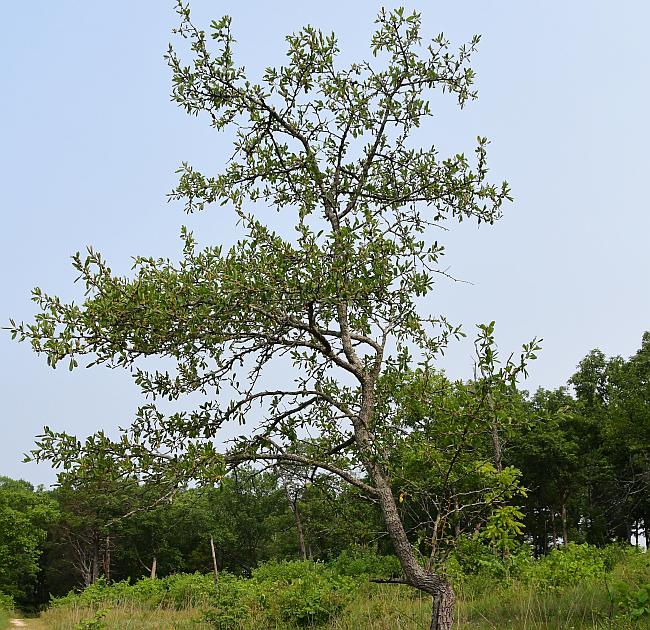Sideroxylon lanuginosum Michx.
Gum Bumelia, Chittim Wood

Native
CC = 5
CW = 3
MOC = 61
© SRTurner
Sideroxylon lanuginosum Michx.Gum Bumelia, Chittim Wood | |
 |
Native CC = 5 CW = 3 MOC = 61 |
© SRTurner |
|
Family - Sapotaceae Habit - Shrub or small tree to 15 m tall. Stems - Bark dark gray, becoming furrowed into narrow scaly ridges. Twigs gray to dark gray, with rust-colored to reddish gray hairs, at least when young, the buds lateral, ovoid, often partially embedded in the twig, the several overlapping scales hairy.
Leaves - Alternate, sometimes appearing fascicled, simple. Petioles short or absent. Blades 2-10 cm long, narrowly oblanceolate to broadly elliptic, tapered at the base, rounded to bluntly pointed at the tip, the undersurface usually moderately pubescent with matted, somewhat spreading, silvery hairs, these with 2 straight or wavy arms attached to a short central stalk, becoming glabrous with age, the upper surface glabrous except along the midvein, often shiny.
Inflorescences - Flowers axillary, solitary or in umbellate clusters.
Flowers - Actinomorphic, perfect, hypogynous. Calyx of 5 free sepals 1.5-2.0 mm long, the lobes broadly elliptic, rounded at the tip, with rust-colored to reddish gray hairs, the lateral margins thinner, glabrous. Corollas 3-4 mm long, the 5 lobes ascending to spreading at maturity, each with a pair of short, petal-like lobes or appendages at the base. Stamens 5, fused to the corolla tube, positioned opposite the corolla lobes. Staminodes 5, similar in size, shape, and color to the corolla lobes but usually somewhat more pointed at the tip, fused to the corolla tube to the inside of the fertile stamens, positioned alternate with the corolla lobes. Pistil 1 per flower, of 5 fused carpels. Ovary superior, with 5 locules, usually hairy, at least toward the base, tapered to the single style. Ovules usually 1 per locule, attached toward the locule base. Stigma not conspicuous, a small obliquely positioned receptive area at the tip of the style.
Fruits - Drupelike berries 9-15 mm long. Seeds 6-9 mm long, the attachment scar irregularly triangular to circular, appearing flat to somewhat notched, usually bisected by a low, narrow ridge. Flowering - June - August. Habitat - Dry upland forests, glades, tops and ledges of exposed bluffs, often but not always on calcareous substrates, railroads, fencerows. Origin - Native to the U.S. Lookalikes - Sideroxylon lycioides, which is rare in Missouri. Other info. - This gnarly, very slow growing tree is common in the southern 2/3 of the state, but apparently absent in the northern counties. The version found in Missouri, ssp. oblongifolium, also occurs throughout Oklahoma, Arkansas, Louisiana, and the eastern half of Texas. These states largely define the subspecies's native range. The plant is recognized by a generally gnarled appearance (probably a product of its very slow growth), obovate leaves with lanate undersides, and umbellate bud or fruit clusters. The leaves are often fasicled, and when these are lost they leave behind a series of short pegs along the branch, which lends a characteristic appearance. The plant's milky sap is responsible for the common name "gum bumelia." Latex released from inner bark layers was used as chewing gum by Native Americans. The wood has been used for furniture and tool handles. Photographs taken at Shaw Nature Reserve, Franklin County, MO, 6-17-2023 and 7-16-2023 (SRTurner). |